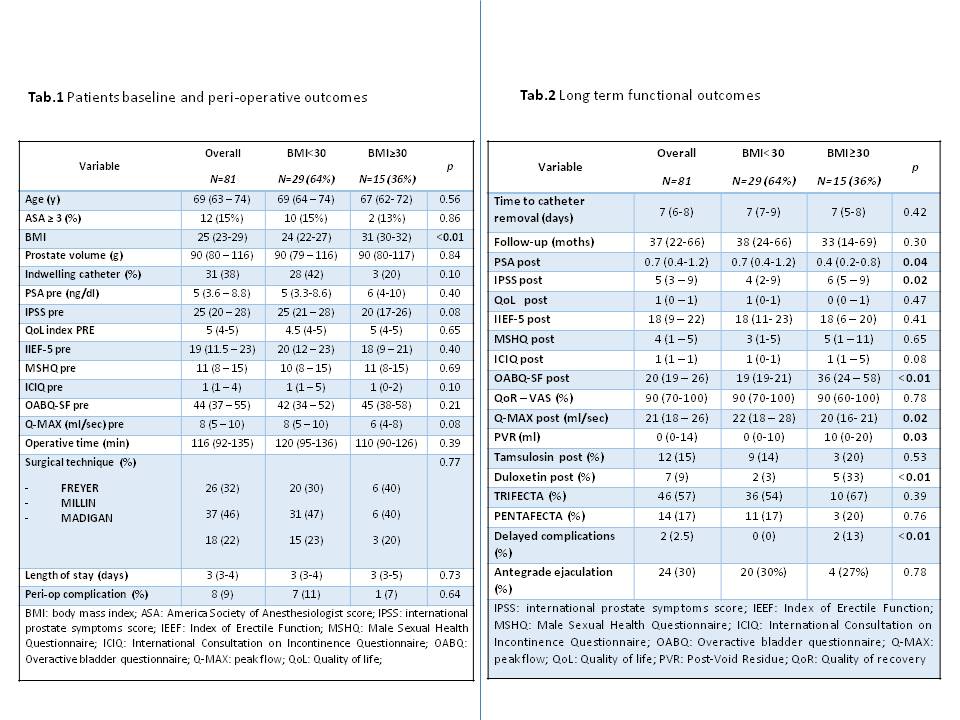Back
Poster, Podium & Video Sessions
MP04: Benign Prostatic Hyperplasia: Surgical Therapy & New Technology II
MP04-20: Impact of obesity on peri-operative and long-term functional outcomes after Robotic Assisted Simple Prostatectomy
Friday, May 13, 2022
8:45 AM – 10:00 AM
Location: Room 228
Alfredo Maria Bove*, Aldo Brassetti, Gabriele Tuderti, Umberto Anceschi, Mariaconsiglia Ferriero, Leonardo Misuraca, Riccardo Mastroianni, Giuseppe Simone, Rome, Italy
- AB
Poster Presenter(s)
Introduction: Robotic simple prostatectomy (RASP) is an effective and safe procedure for severe bladder outlet obstructive symptoms relief. Over the years, obesity became a worldwide epidemic disorder in western Countries, increasing the overall morbidity and mortality rate. In this study we investigated the impact of obesity on peri-operative and long-term functional outcomes of RASP.
Methods: Pre-operative assessments included: Demographics, flowmetry parameters and Validated questionnaires: International Index of Erectile Function (IIEF), and International Consultation on Incontinence Questionnaire (ICIQ), International prostatic symptoms score (IPSS) with its quality of life (QoL) score, Male Sexual Health Questionnaire (MSHQ), Overactive bladder questionnaire (OAB-Q) and Quality of Recovery visual analogue scale (QoR-VAS) . Follow-up assessments included Flowmetry and validated questionnaires. Trifecta was defined as: post-operative Q-max>15 ml/sec, IPSS score <8 and absence of complications. Pentafecta included also post-operative ejaculation persistence (MSHQ score>0) and the Erectile function maintenance (?IEEF <6). Data were stratified by BMI ( <30 or =30).
Results: Overall, 81 patients underwent RASP between 2012 and 2020 in our Institution. Baseline demographics and clinical features, questionnaires score and baseline flowmetry results were comparable between obese and non-obese cohorts (Table 1). At a median follow-up of 37 months, obese patients reported a significantly lower subjective improvement in IPSS (p=0.02) and OABQ scores (p < 0.001) and higher incidence of stress incontinence requiring Duloxetin (p < 0.001). Flowmetry outcomes, namely Q-max and post void residual volume, were also worse in this cohort (p=0.02 and p=0.03, respectively [Table 2]). Nonetheless, at comprehensive outcomes assessment, obese patients had comparable Trifecta (67% vs 54%, p=0.39) and pentafecta achievement rate (20% vs 17%, p=0.76) .
Conclusions: Our prelimirary results proved that obesity is associated with worse objectively assessed functional outcomes (storage LUTS and incontinence rate) after RASP. At comprehensive assessments of outcomes by means of trifecta and pentafecta, obese patients reported outcomes comparable to non-obese population.
Source of Funding: None

Methods: Pre-operative assessments included: Demographics, flowmetry parameters and Validated questionnaires: International Index of Erectile Function (IIEF), and International Consultation on Incontinence Questionnaire (ICIQ), International prostatic symptoms score (IPSS) with its quality of life (QoL) score, Male Sexual Health Questionnaire (MSHQ), Overactive bladder questionnaire (OAB-Q) and Quality of Recovery visual analogue scale (QoR-VAS) . Follow-up assessments included Flowmetry and validated questionnaires. Trifecta was defined as: post-operative Q-max>15 ml/sec, IPSS score <8 and absence of complications. Pentafecta included also post-operative ejaculation persistence (MSHQ score>0) and the Erectile function maintenance (?IEEF <6). Data were stratified by BMI ( <30 or =30).
Results: Overall, 81 patients underwent RASP between 2012 and 2020 in our Institution. Baseline demographics and clinical features, questionnaires score and baseline flowmetry results were comparable between obese and non-obese cohorts (Table 1). At a median follow-up of 37 months, obese patients reported a significantly lower subjective improvement in IPSS (p=0.02) and OABQ scores (p < 0.001) and higher incidence of stress incontinence requiring Duloxetin (p < 0.001). Flowmetry outcomes, namely Q-max and post void residual volume, were also worse in this cohort (p=0.02 and p=0.03, respectively [Table 2]). Nonetheless, at comprehensive outcomes assessment, obese patients had comparable Trifecta (67% vs 54%, p=0.39) and pentafecta achievement rate (20% vs 17%, p=0.76) .
Conclusions: Our prelimirary results proved that obesity is associated with worse objectively assessed functional outcomes (storage LUTS and incontinence rate) after RASP. At comprehensive assessments of outcomes by means of trifecta and pentafecta, obese patients reported outcomes comparable to non-obese population.
Source of Funding: None


.jpg)
.jpg)